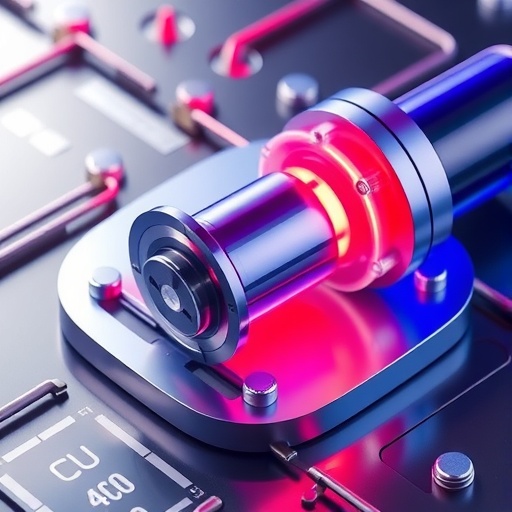
image: Atomic-resolution image of a superconducting germanium gallium (Ge:Ga) trilayer with the alternating Ge:Ga and silicon (Si) layers demonstrating precise control of atomic interfaces, a key step toward quantum devices.
view more
Credit: Salva Salmani-Rezaie
Scientists have paved the way for next-generation quantum circuits by successfully making a semiconducting element commonly used in electrical devices superconducting.
A research team from The University of Queensland’s School of Mathematics and Physics and Australian Institute for Bioengineering and Nanotechnology and New York University have shown germanium can conduct electricity without resistance.
The discovery, which had eluded physicists for more than 60 years, unifies the building blocks of classical electronics and quantum technologies.
Dr Peter Jacobson said the result opens a pathway for a new era of hybrid quantum devices.
“These materials could underpin future quantum circuits, sensors and low-power cryogenic electronics, all of which need clean interfaces between superconducting and semiconducting regions,” Dr Jacobson said.
“Germanium is already a workhorse material for advanced semiconductor technologies, so by showing it can also become superconducting under controlled growth conditions there’s now potential for scalable, foundry-ready quantum devices.”
Dr Julian Steele said previous efforts to integrate superconductivity directly into semiconductor platforms had failed when structural disorder and atomic-scale imperfections were introduced.
“Rather than ion implantation, molecular beam epitaxy (MBE) was used to precisely incorporate gallium atoms into the germanium’s crystal lattice,” Dr Steele said.
“Using epitaxy – growing thin crystal layers – means we can finally achieve the structural precision needed to understand and control how superconductivity emerges in these materials.”
Dr Carla Verdi showed this ordered atomic structure reshapes the electronic bands in a way that naturally supports superconductivity.
“This theoretical work confirmed that gallium atoms substitute neatly into the germanium lattice, creating the electronic conditions for superconductivity,” Dr Verdi said.
“It’s an elegant example of how computation and experiment together can solve a problem that has challenged materials science for more than half a century.”
The research has been published in Nature Nanotechnology.
Collaboration and acknowledgements
The work was a collaboration between UQ, New York University, ETH Zürich and Ohio State University.
The Australian team performed experiments at ANSTO’s Australian Synchrotron and computational work was carried out using national high-performance computing resources.
Dr Peter Jacobson and Dr Carla Verdi are at UQ’s School of Mathematics and Physics. Dr Julian Steele has a dual affiliation with UQ’s Australian Institute for Bioengineering and Nanotechnology and the School of Mathematics and Physics.
Journal
Nature Nanotechnology
DOI
10.1038/s41565-025-02042-8
Method of Research
Experimental study
Subject of Research
Not applicable
Article Title
Superconductivity in Hyperdoped Epitaxial Ge thin films by Ga Substitution
Article Publication Date
31-Oct-2025
COI Statement
There are no competing interests to declare.
Media Contact
Emma Blackwood
University of Queensland
Journal
Nature Nanotechnology
Funder
United States Air Force Office of Scientific Research,
National Computational Merit Allocation Scheme,
Australian Research Council,
Australian Research Council,
Australian Research Council
DOI
10.1038/s41565-025-02042-8
Journal
Nature Nanotechnology
DOI
10.1038/s41565-025-02042-8
Method of Research
Experimental study
Subject of Research
Not applicable
Article Title
Superconductivity in Hyperdoped Epitaxial Ge thin films by Ga Substitution
Article Publication Date
31-Oct-2025
COI Statement
There are no competing interests to declare.
Keywords
/Physical sciences/Physics
bu içeriği en az 2000 kelime olacak şekilde ve alt başlıklar ve madde içermiyecek şekilde ünlü bir science magazine için İngilizce olarak yeniden yaz. Teknik açıklamalar içersin ve viral olacak şekilde İngilizce yaz. Haber dışında başka bir şey içermesin. Haber içerisinde en az 12 paragraf ve her bir paragrafta da en az 50 kelime olsun. Cevapta sadece haber olsun. Ayrıca haberi yazdıktan sonra içerikten yararlanarak aşağıdaki başlıkların bilgisi var ise haberin altında doldur. Eğer yoksa bilgisi ilgili kısmı yazma.:
Subject of Research:
Article Title:
News Publication Date:
Web References:
References:
Image Credits:
Keywords
Tags: advancements in nanotechnologyatomic-resolution imagingelectrical devices technologygermanium gallium trilayersphysicists research achievementsquantum circuits developmentquantum device fabricationresistance-free electricity conductionsemiconducting elementssuperconducting germanium productionsuperconductivity breakthroughsUniversity of Queensland research





